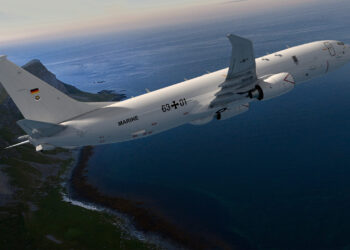DCN,
TOULON, France: The CVN Charles de Gaulle refit and upgrade was completed on 1 December 2008. Prime contractor DCNS conducted this exceptional shipyard project at a sustained pace to complete it on time in just 15 months.
The Group successfully coordinated the efforts of its own teams, subcontractors, the ship's crew and Navy fleet maintenance teams.
The main aims were to refurbish the ship and its systems, overhaul and refuel the nuclear reactors, modernise the command information and communication systems, and modify the ship to accommodate new weapon systems scheduled to be introduced in 2009, including Rafale combat aircraft to standard F3 and ASMP-A and Scalp Naval missiles.
“Thanks to flawless industrial organisation, DCNS as prime contractor completed the main refit tasks on time and on budget and without compromising working conditions or safety,” says DCNS Executive Vice President & COO Bernard Planchais. “In engineering terms, the refuelling of the nuclear reactors represented a major first in view of the measures adopted to ensure complete nuclear safety. The industrial organisation was also exemplary as regards the pooling of expertise and skills by all parties, including the Navy, its Fleet Support Service (SSF), the ship’s crew and an array of subcontractors led by Areva TA, not to mention the Group’s own teams. The project’s successful completion is a tribute to the professionalism of each and every team and to the Group’s capacity to take on the most ambitious challenges,” says Bernard Planchais.
After a refit and upgrade completed in the contractually agreed time of just 15 months, DCNS handed CVN Charles de Gaulle back to the French Navy which will now ramp the ship up to full operational readiness.
The data below summarise the scale of this exceptional project in both human and engineering terms.
Duration:
*preparation: 3 years
*shipyard: 15 months
Number of person-hours of work: 2,530,000, including:
*1,200,000 by DCNS teams and subcontractors
*1,200,000 by the ship's crew
*130,000 by fleet maintenance teams (Atelier Militaire de la Flotte)
Number of people involved: 1,700, including:
*600 employees of DCNS and subcontractors
*1,000 members of ship's crew
*100 fleet maintenance employees
Number of tasks: 80,000
Other:
*paint stripped then re-applied: 40 tonnes
*cabling installed: over 80 km
*fuel rods replaced: 32 for each of the two reactors
Budget for shipyard work: EUR 300 million
ADDITIONAL DETAILS CONCERNING MAIN TASKS
The scheduling constraints of reactor refuelling determined the rest of the refit schedule. More specifically, while the two reactor cores were being refuelled and the entire stream generating system checked out, a large number of tasks were programmed for other systems and areas.
The propulsion system was overhauled and inspected from the steam turbines to the propellers. The entire 11,000-sq.m hull was stripped then re-painted and the 7,800-sq.m flight deck resurfaced. For these two operations, DCNS adopted an environment-friendly process using industrial-scale high-pressure water jets. This new technique, tested and approved earlier by DCNS as part of the refitting of French Navy frigate Dupleix, significantly reduced the amount of waste.
The catapults, arresting gear and other flight deck systems were overhauled and inspected. The replacement of three of the ship’s cooling plants, in compliance with new environmental standards, involved cutting holes in the hull for plant removal and installation.
DCNS modified the ship to accommodate Rafale combat aircraft to standard F3 and updated the command information and communication systems to the latest technological standards. The new Syracuse III terminal gives the ship significantly improved bandwidth for satellite communications which, in turn, will greatly simplify direct, high-speed data links between the ship and its aircraft. Over 80 km of new cable was installed, much of it for the new telephony-over-IP network which also offers extensive internet access.
Over the 15 months between 1 September 2007 and 1 December 2008, DCNS successfully completed this exceptional project for its prime customer, the French Navy. In so doing, the Group significantly expanded its naval support service capabilities.
The DCNS Group is one of Europe’s leading players on the world market for naval defence systems. To meet customer demands for more comprehensive and integrated systems, DCNS acts as prime contractor for naval shipbuilding, integration and support by combining its own development, marketing and production capabilities with those of selected partners. To manage the complexity of such projects, the Group draws on in-house expertise in naval architecture and systems engineering, ship assembly and integration and equipment design and production, as well as through-life support. The DCNS Group employs 13,000 people and generates annual revenues of around EUR 2.8 billion.









